Related Research Articles

The Florida salt marsh vole is a North American vole endemic to the state of Florida in the United States.
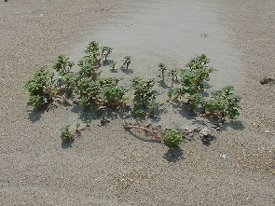
Amaranthus pumilus, the seaside amaranth or seabeach amaranth, is a species of amaranth. This annual plant is now a threatened species, although it was formerly scattered along the eastern coast of the United States, its native range.
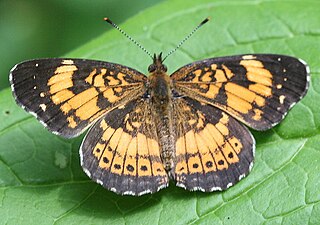
Chlosyne nycteis, the silvery checkerspot, is a species of Nymphalinae butterfly that occurs in North America. It is listed as a species of special concern in Connecticut and Maine, and is believed extirpated in Connecticut, Massachusetts, and New Hampshire.
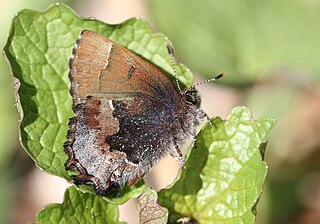
Callophrys henrici, the Henry's elfin or woodland elfin, is a North American butterfly in the family Lycaenidae. In Canada it is found from southern Manitoba to southern Nova Scotia. It has two main groups of populations in the United States; the first is found along the Atlantic Coast and uses various hollies (Ilex) as host plants; and the second is found mainly in the north and the Appalachians where they use redbud as a host plant. Henry's elfin is increasing in New England because of an introduced buckthorn it now uses as a host plant. It is listed as a species of special concern in the US state of Connecticut.

The Appalachian azure is a butterfly in the gossamer wings family Lycaenidae. The male is light blue on the upperwing with a narrow, dark line running along the edge of the forewing. The underwing is chalky white and is dotted with small, pale dark spots. The very back of the hindwing has a row of dark spots running along the edge and contained by a faint zigzagging band. Females are similar to the males but have broad dark wing borders instead of the male's narrow ones. The adult butterfly has a 1.1–1.4-inch (2.8–3.6 cm) wingspan. It is the largest azure in the area.

Callophrys irus, the frosted elfin, is a species of Lycaenidae that is native to North America.
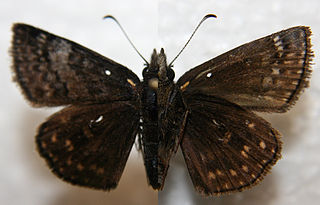
Erynnis brizo, the sleepy duskywing or banded oak duskywing, is a species of Hesperiidae butterfly that occurs throughout North America and is commonly confused with E. juvenalis and E. lucilius. The species is listed as threatened in Connecticut and Maine.
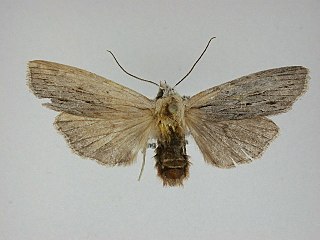
Lithophane lemmeri, Lemmer's noctuid moth or Lemmer's pinion, is a moth of the family Noctuidae. It is found in the eastern parts of the United States and adjacent areas in Canada. It is listed as a species of special concern in the US state of Connecticut. The species was first described by William Barnes and Foster Hendrickson Benjamin in 1929.

Catocala pretiosa, the precious underwing, is a moth of the family Erebidae. The species was first described by Joseph Albert Lintner in 1876. It was included in Catocala crataegi by many authors, but recently it has been revalidated as a distinct species. The subspecies of pretiosa is listed as a species of special concern and believed extirpated in the US state of Connecticut.
Acronicta falcula, the corylus dagger moth, is a moth of the family Noctuidae. The species was first described by Augustus Radcliffe Grote in 1877. It is found in the United States and Canada from southern New England to southern Manitoba and Iowa. Recently seen from Wisconsin, Connecticut, Rhode Island, New York and Michigan. It is reported as rare in Ohio. It is listed as a species of special concern in the US state of Connecticut.
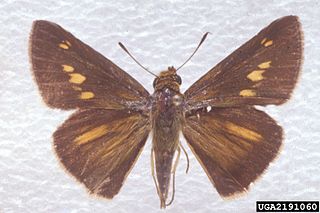
Euphyes dion, the Dion skipper or Alabama skipper, is a species of butterfly of the family Hesperiidae. It is found in scattered populations along the Atlantic coast of North America, from western Massachusetts and south-eastern New York south to north-eastern Florida, west to north-eastern Texas, and north to south-eastern North Dakota, northern Wisconsin, southern Ontario and southern Quebec. It is listed as a species of special concern in the US state of Connecticut.
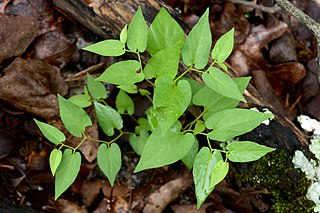
Aristolochia serpentaria is a species of perennial flowering plant in the Aristolochiaceae (birthwort) family. The species is commonly known as Virginia snakeroot and is native to eastern North America, from Connecticut to southern Michigan and south to Texas and Florida.

Symphyotrichum prenanthoides is a species of flowering plant in the family Asteraceae known by the common name crookedstem aster. It is native to northcentral and northeastern North America.
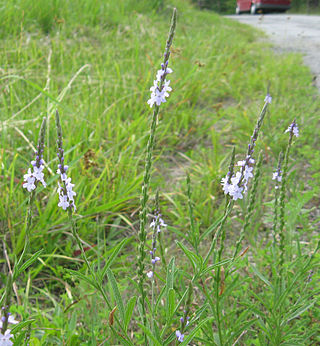
Verbena simplex, commonly known as narrowleaf vervain, is a perennial herbaceous plant plant in the Verbenaceae (vervain) family. It is native to central and eastern North America where it is found in open, dry, habitats on calcareous soil. It produces lavender flowers in the summer.
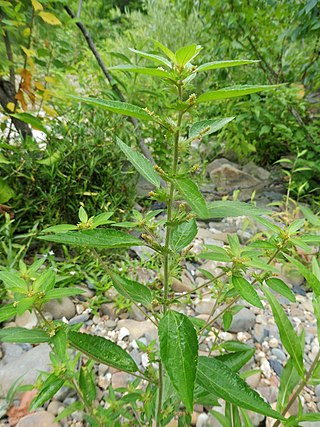
Acalypha virginica, commonly called Virginia threeseed mercury or Virginia copperleaf, is a plant in the spurge family (Euphorbiaceae). It is native to the eastern United States. It is found in a variety of natural habitats, particularly in open woodlands and along riverbanks. It is a somewhat weedy species that responds positively to ecological disturbance, and can be found in degraded habitats such as agricultural fields.
Speranza exonerata, the barrens itame, is a moth of the family Geometridae described by Douglas C. Ferguson in 2008. It is found in Massachusetts, New Hampshire, Pennsylvania and New Jersey. It is listed as threatened in the US state of Connecticut.
Chaetaglaea cerata, the waxed sallow, is a species of moth in the family Noctuidae described by John G. Franclemont in 1943. It is found in North America, where it has been recorded from Connecticut, Indiana, Maine, Michigan, Ohio, Ontario, Pennsylvania and Wisconsin.
Papaipema maritima, the maritime sunflower borer moth, is a species of moth found in North America. The species was first described by Henry Bird in 1909. The larvae bore into the stems of Helianthus giganteus, forming a stem gall. It is listed as a species of special concern and believed extirpated in the US state of Connecticut.
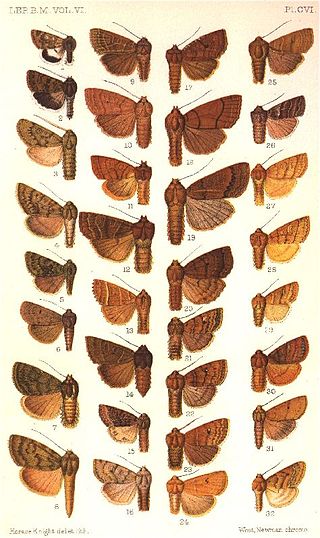
Pyreferra ceromatica, the anointed sallow moth, is a species of moth native to North America. In the US state of Connecticut it is listed as a species of special concern and is believed to be extirpated. It was described by Augustus Radcliffe Grote in 1874.

Charles E. Wheeler Wildlife Management Area is a 625-acre (253 ha) brackish tidal marsh, nature preserve and hunting area owned by the state of Connecticut located in Devon (village), Milford, New Haven County, Connecticut.
References
- ↑ "NatureServe Explorer 2.0".
- ↑ "NatureServe Explorer 2.0".
- ↑ "Connecticut's Endangered, Threatened and Special Concern Species 2015". State of Connecticut Department of Energy and Environmental Protection Bureau of Natural Resources. Retrieved January 31, 2018.